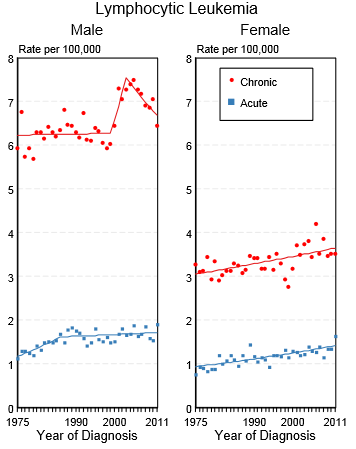Acute lymphoblastic leukemia epidemiology and demographics: Difference between revisions
Carlos Lopez (talk | contribs) |
Carlos Lopez (talk | contribs) No edit summary |
||
| Line 5: | Line 5: | ||
==Overview== | ==Overview== | ||
American Cancer Society estimated in 2015 that new cases and deaths from Acute lymphocytic leukemia in the United States will be 6,250 and 1,450 respectively. The age-adjusted [[prevalence]] of acute lymphoblastic leukemia (ALL) is 17.4 per 100,000 in 2011.<ref name="SEER">Howlader N, Noone AM, Krapcho M, Garshell J, Miller D, Altekruse SF, Kosary CL, Yu M, Ruhl J, Tatalovich Z,Mariotto A, Lewis DR, Chen HS, Feuer EJ, Cronin KA (eds). SEER Cancer Statistics Review, 1975-2011, National Cancer Institute. Bethesda, MD, http://seer.cancer.gov/csr/1975_2011/, based on November 2013 SEER data submission, posted to the SEER web site, April 2014.</ref> There is an increased incidence in people with [[Down syndrome|Down's Syndrome]], [[Fanconi's anemia]], [[Bloom's syndrome]], [[ataxia-telangiectasia]], [[X-linked agammaglobulinemia]] and [[severe combined immunodeficiency]]. ALL accounts for approximately 80 percent of all childhood [[leukemia]] cases, making it the most common type of childhood cancer. | |||
== Epidemiology and Demographics == | == Epidemiology and Demographics == | ||
Revision as of 19:59, 25 August 2015
|
Acute lymphoblastic leukemia Microchapters |
|
Differentiating Acute lymphoblastic leukemia from other Diseases |
|---|
|
Diagnosis |
|
Treatment |
|
Case Studies |
|
Acute lymphoblastic leukemia epidemiology and demographics On the Web |
|
American Roentgen Ray Society Images of Acute lymphoblastic leukemia epidemiology and demographics |
|
FDA on Acute lymphoblastic leukemia epidemiology and demographics |
|
CDC on Acute lymphoblastic leukemia epidemiology and demographics |
|
Acute lymphoblastic leukemia epidemiology and demographics in the news |
|
Blogs on Acute lymphoblastic leukemia epidemiology and demographics |
|
Directions to Hospitals Treating Acute lymphoblastic leukemia |
|
Risk calculators and risk factors for Acute lymphoblastic leukemia epidemiology and demographics |
Editor-In-Chief: C. Michael Gibson, M.S., M.D. [1]; Associate Editor(s)-in-Chief: Raviteja Guddeti, M.B.B.S. [2]; Rim Halaby, M.D. [3]
Overview
American Cancer Society estimated in 2015 that new cases and deaths from Acute lymphocytic leukemia in the United States will be 6,250 and 1,450 respectively. The age-adjusted prevalence of acute lymphoblastic leukemia (ALL) is 17.4 per 100,000 in 2011.[1] There is an increased incidence in people with Down's Syndrome, Fanconi's anemia, Bloom's syndrome, ataxia-telangiectasia, X-linked agammaglobulinemia and severe combined immunodeficiency. ALL accounts for approximately 80 percent of all childhood leukemia cases, making it the most common type of childhood cancer.
Epidemiology and Demographics
Incidence and Mortality 2015
- Estimated new cases and deaths from ALL in the United States in 2015[2]
- New cases: 6,250.
- Deaths: 1,450.
Prevalence
- In the United States, the age-adjusted prevalence of ALL is 17.4 per 100,000 in 2011.[1]
Incidence
- The number of annual ALL cases in the US is roughly 4000, 3000 of which inflict children.
- There is an increased incidence in people with Down's Syndrome, Fanconi's anemia, Bloom's syndrome, ataxia-telangiectasia, X-linked agammaglobulinemia and severe combined immunodeficiency.
- In 2011, the age-adjusted incidence of ALL was 1.77 per 100,000 persons in the United States.[1]
Age
- ALL accounts for approximately 80 percent of all childhood leukemia cases, making it the most common type of childhood cancer.
- It has a peak incident rate of 2-5 years old, decreasing in incidence with increasing age before increasing again at around 50 years old.
- While the overall age-adjusted incidence of ALL in the United States between 2007 and 2011 is 1.7 per 100,000, the age-adjusted incidence of ALL by age category is:[1]
- Under 65 years: 1.7 per 100,000
- 65 and over: 1.6 per 100,000
Gender
- ALL is slightly more common in males than females.
- In the United States, the age-adjusted prevalence of ALL by gender in 2011 is:[1]
- In males: 19.3 per 100,000
- In females: 15.4 per 100,000
- In the United States, the age-adjusted incidence of ALL by gender on 2011 is:[1]
- In males: 1.9 per 100,000 persons
- In females: 1.63 per 100,000 persons
- Shown below is an image depicting the observed incidence of lymphocytic leukemia by gender in the United States between 1975 and 2011. These graphs are adapted from SEER: The Surveillance, Epidemiology, and End Results Program of the National Cancer Institute.[1]
Race
- Shown below is a table depicting the age-adjusted prevalence of ALL by race in 2011 in the United States.[1]
| All Races | White | Black | Asian/Pacific Islander | Hispanic | |
| Age-adjusted prevalence | 17.4 per 100,000 | 20 per 100,000 | 7.6 per 100,000 | 13.2 per 100,000 | 20.8 per 100,000 |
References
- ↑ 1.0 1.1 1.2 1.3 1.4 1.5 1.6 1.7 Howlader N, Noone AM, Krapcho M, Garshell J, Miller D, Altekruse SF, Kosary CL, Yu M, Ruhl J, Tatalovich Z,Mariotto A, Lewis DR, Chen HS, Feuer EJ, Cronin KA (eds). SEER Cancer Statistics Review, 1975-2011, National Cancer Institute. Bethesda, MD, http://seer.cancer.gov/csr/1975_2011/, based on November 2013 SEER data submission, posted to the SEER web site, April 2014.
- ↑ "National Cancer Institurte".
